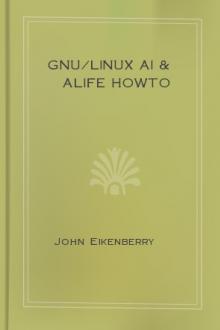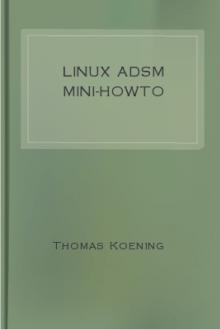GNU/Linux AI & Alife HOWTO, John Eikenberry [best books to read for self development TXT] 📗

- Author: John Eikenberry
- Performer: -
Book online «GNU/Linux AI & Alife HOWTO, John Eikenberry [best books to read for self development TXT] 📗». Author John Eikenberry
pattern matching algorithm. LISA also provides the ability to
reason over ordinary CLOS objects.
NICOLE
� Web site: nicole.sourceforge.net
NICOLE (Nearly Intelligent Computer Operated Language Examiner)
is a theory or experiment that if a computer is given enough
combinations of how words, phrases and sentences are related to
one another, it could talk back to you. It is an attempt to
simulate a conversation by learning how words are related to
other words. A human communicates with NICOLE via the keyboard
and NICOLE responds back with its own sentences which are
automatically generated, based on what NICOLE has stored in it’s
database. Each new sentence that has been typed in, and NICOLE
doesn’t know about, is included into NICOLE’s database, thus
extending the knowledge base of NICOLE.
NLTK
� Web site: nltk.sourceforge.net
NLTK, the Natural Language Toolkit, is a suite of Python
libraries and programs for symbolic and statistical natural
language processing. NLTK includes graphical demonstrations and
sample data. It is accompanied by extensive documentation,
including tutorials that explain the underlying concepts behind
the language processing tasks supported by the toolkit.
NLTK is ideally suited to students who are learning NLP (natural
language processing) or conducting research in NLP or closely
related areas, including empirical linguistics, cognitive
science, artificial intelligence, information retrieval, and
machine learning. NLTK has been used successfully as a teaching
tool, as an individual study tool, and as a platform for
prototyping and building research systems.
Otter: An Automated Deduction System
� Web site: www-unix.mcs.anl.gov/AR/otter/
Our current automated deduction system Otter is designed to
prove theorems stated in first-order logic with equality.
Otter’s inference rules are based on resolution and
paramodulation, and it includes facilities for term rewriting,
term orderings, Knuth-Bendix completion, weighting, and
strategies for directing and restricting searches for proofs.
Otter can also be used as a symbolic calculator and has an
embedded equational programming system.
PVS
� Web site: pvs.csl.sri.com/
PVS is a verification system: that is, a specification language
integrated with support tools and a theorem prover. It is
intended to capture the state-of-the-art in mechanized formal
methods and to be sufficiently rugged that it can be used for
significant applications. PVS is a research prototype: it
evolves and improves as we develop or apply new capabilities,
and as the stress of real use exposes new requirements.
SNePS
� Web site: www.cse.buffalo.edu/sneps/
The long-term goal of The SNePS Research Group is the design and
construction of a natural-language-using computerized cognitive
agent, and carrying out the research in artificial intelligence,
computational linguistics, and cognitive science necessary for
that endeavor. The three-part focus of the group is on knowledge
representation, reasoning, and natural-language understanding
and generation. The group is widely known for its development of
the SNePS knowledge representation/reasoning system, and Cassie,
its computerized cognitive agent.
Soar
� Web site: sitemaker.umich.edu/soar
Soar has been developed to be a general cognitive architecture.
We intend ultimately to enable the Soar architecture to:
� work on the full range of tasks expected of an intelligent
agent, from highly routine to extremely difficult, open-ended
problems
� represent and use appropriate forms of knowledge, such as
procedural, declarative, episodic, and possibly iconic
� employ the full range of problem solving methods
� interact with the outside world and
� learn about all aspects of the tasks and its performance on
them.
In other words, our intention is for Soar to support all the
capabilities required of a general intelligent agent.
TCM
� Web site: wwwhome.cs.utwente.nl/~tcm/
� FTP site: ftp.cs.utwente.nl/pub/tcm/
TCM (Toolkit for Conceptual Modeling) is our suite of graphical
editors. TCM contains graphical editors for Entity-Relationship
diagrams, Class-Relationship diagrams, Data and Event Flow
diagrams, State Transition diagrams, Jackson Process Structure
diagrams and System Network diagrams, Function Refinement trees
and various table editors, such as a Function-Entity table
editor and a Function Decomposition table editor. TCM is easy
to use and performs numerous consistency checks, some of them
immediately, some of them upon request.
Yale
� Web site: yale.sf.net/
� Alt Web site: rapid-i.com/
YALE (Yet Another Learning Environment) is an environment for
machine learning experiments. Experiments can be made up of a
large number of arbitrarily nestable operators and their setup
is described by XML files which can easily created with a
graphical user interface. Applications of YALE cover both
research and real-world learning tasks.
WEKA
� Web site: lucy.cs.waikato.ac.nz/~ml/
WEKA (Waikato Environment for Knowledge Analysis) is an state-of-the-art facility for applying machine learning techniques to
practical problems. It is a comprehensive software “workbench”
that allows people to analyse real-world data. It integrates
different machine learning tools within a common framework and a
uniform user interface. It is designed to support a “simplicity-first” methodology, which allows users to experiment
interactively with simple machine learning tools before looking
for more complex solutions.
3. ConnectionismConnectionism is a technical term for a group of related techniques.
These techniques include areas such as Artificial Neural Networks,
Semantic Networks and a few other similar ideas. My present focus is
on neural networks (though I am looking for resources on the other
techniques). Neural networks are programs designed to simulate the
workings of the brain. They consist of a network of small
mathematical-based nodes, which work together to form patterns of
information. They have tremendous potential and currently seem to be
having a great deal of success with image processing and robot
control.
3.1. Connectionist class/code libraries
These are libraries of code or classes for use in programming within
the Connectionist field. They are not meant as stand alone
applications, but rather as tools for building your own applications.
Software for Flexible Bayesian Modeling
� Web site: www.cs.utoronto.ca/~radford/fbm.software.html
This software implements flexible Bayesian models for regression
and classification applications that are based on multilayer
perceptron neural networks or on Gaussian processes. The
implementation uses Markov chain Monte Carlo methods. Software
modules that support Markov chain sampling are included in the
distribution, and may be useful in other applications.
BELIEF
� Web site: www.cs.cmu.edu/afs/cs/project/ai-repository/ai/areas/reasonng/probabl/belief/
BELIEF is a Common Lisp implementation of the Dempster and Kong
fusion and propagation algorithm for Graphical Belief Function
Models and the Lauritzen and Spiegelhalter algorithm for
Graphical Probabilistic Models. It includes code for
manipulating graphical belief models such as Bayes Nets and
Relevance Diagrams (a subset of Influence Diagrams) using both
belief functions and probabilities as basic representations of
uncertainty. It uses the Shenoy and Shafer version of the
algorithm, so one of its unique features is that it supports
both probability distributions and belief functions. It also
has limited support for second order models (probability
distributions on parameters).
bpnn.py
� Web site: http://arctrix.com/nas/python/bpnn.py
A simple back-propogation ANN in Python.
CNNs
� Web site: www.isi.ee.ethz.ch/~haenggi/CNNsim.html
� Newer Version:
www.isi.ee.ethz.ch/~haenggi/CNNsim_adv_manual.html
� Old Page: www.ce.unipr.it/research/pardis/CNN/cnn.html
Cellular Neural Networks (CNN) is a massive parallel computing
paradigm defined in discrete N-dimensional spaces.
CONICAL
� Web site: strout.net/conical/
CONICAL is a C++ class library for building simulations common
in computational neuroscience. Currently its focus is on
compartmental modeling, with capabilities similar to GENESIS and
NEURON. A model neuron is built out of compartments, usually
with a cylindrical shape. When small enough, these open-ended
cylinders can approximate nearly any geometry. Future classes
may support reaction-diffusion kinetics and more. A key feature
of CONICAL is its cross-platform compatibility; it has been
fully co-developed and tested under Unix, DOS, and Mac OS.
Jet’s Neural Architecture
� Web site: www.voltar-confed.org/jneural/
Jet’s Neural Architecture is a C++ framework for doing neural
net projects. The goals of this project were to make a fast,
flexible neural architecture that isn’t stuck to one kind of net
and to make sure that end users could easily write useful
applications. All the documentation is also easily readable.
Joone
� Web site: www.jooneworld.com
Joone is a neural net framework to create, train and test neural
nets. The aim is to create a distributed environment based on
JavaSpaces both for enthusiastic and professional users, based
on the newest Java technologies. Joone is composed of a central
engine that is the fulcrum of all applications that already
exist or will be developed. The neural engine is modular,
scalable, multitasking and tensile. Everyone can write new
modules to implement new algorithms or new architectures
starting from the simple components distributed with the core
engine. The main idea is to create the basis to promote a
zillion of AI applications that revolve around the core
framework.
Matrix Class
� FTP site: ftp.cs.ucla.edu/pub/
A simple, fast, efficient C++ Matrix class designed for
scientists and engineers. The Matrix class is well suited for
applications with complex math algorithms. As an demonstration
of the Matrix class, it was used to implement the backward error
propagation algorithm for a multilayer feedforward artificial
neural network.
Neural Networks at your Fingertips
� Web site: www.neural-networks-at-your-fingertips.com
A set of ANSI C packages that illustrate Adaline networks, backpropagation, the Hopfield model, BAM, Boltzman, CPN, SOM, and
ART1. Coded in portable, self-contained ANSI C. With complete
example applications from a variety of well-known application
domains.
NEURObjects
� Web site: www.disi.unige.it/person/ValentiniG/NEURObjects/
NEURObjects is a set of C++ library classes for neural
networks development. The main goal of the library consists in
supporting researchers and practitioners in developing new
neural network methods and applications, exploiting the
potentialities of object-oriented design and programming.
NEURObjects provides also general purpose applications for
classification problems and can be used for fast prototyping of
inductive machine learning applications.
Pulcinella
� Web site: iridia.ulb.ac.be/pulcinella/
Pulcinella is written in CommonLisp, and appears as a library of
Lisp functions for creating, modifying and evaluating valuation
systems. Alternatively, the user can choose to interact with
Pulcinella via a graphical interface (only available in Allegro
CL). Pulcinella provides primitives to build and evaluate
uncertainty models according to several uncertainty calculi,
including probability theory, possibility theory, and Dempster-Shafer’s theory of belief functions; and the possibility theory
by Zadeh, Dubois and Prade’s. A User’s Manual is available on
request.
scnANNlib
� Web site: www.sentinelchicken.org/projects/scnANNlib/
SCN Artificial Neural Network Library provides a programmer with
a simple object-oriented API for constructing ANNs. Currently,
the library supports non-recursive networks with an arbitrary
number of layers, each with an arbitrary number of nodes.
Facilities exist for training with momentum, and there are plans
to gracefully extend the functionality of the library in later
releases.
UTCS Neural Nets Research Group Software
� Web site: nn.cs.utexas.edu/pages/software/software.html
A bit different from the other entries, this is a reference to a
collection of software rather than one application. It was all
developed by the UTCS Neural Net Research Group. Here’s
a summary of the packages available:
� Natural Language Processing
� MIR - Tcl/Tk-based rapid prototyping for sentence
processing
� SPEC - Parsing complex sentences
� DISCERN - Processing script-based stories, including
� PROC - Parsing, generation, question answering
� HFM - Episodic memory organization
� DISLEX - Lexical processing
� DISCERN - The full integrated model
� FGREPNET - Learning distributed representations
� Self-Organization
� LISSOM - Maps with self-organizing lateral connections.
� FM - Generic Self-Organizing Maps
� Neuroevolution
� Enforced SubPopulations (ESP) for sequential decision
tasks
� Non-Markov Double Pole Balancing
� Symbiotic, Adaptive NeuroEvolution (SANE; predecessor of
ESP)
� JavaSANE - Java software package for applying SANE to
new tasks
� SANE-C - C version, predecessor of JavaSANE
� Pole Balancing - Neuron-level SANE on the





Comments (0)